7 most effective exercises for breast lift at home - a complex for women and girls
Elastic, toned breasts are the pride of women and the admiration of men. But a chic neckline is not only an aesthetic pleasure. It is also a subconscious signal to the opposite sex that in front of a man is a successful future mother, capable of fully raising offspring.
There is something to fight for. And help in achieving the goal, in addition to a balanced diet and cosmetic care for the skin of the chest, thoughtful and most effective exercises for breast lift at home. But first - briefly about how the female breast is arranged.
The zone of the female decollete can be conditionally divided into two components: the mammary gland, which does not have muscle fibers, and the muscular corset that supports it. Between themselves - to provide nutrition to the gland, supply it with oxygen and remove oxidation products - they are connected by connective tissue with a network of blood vessels.
So, the mammary gland has no muscles. What does it consist of? These two seemingly simple hemispheres, unlike muscles, have a very complex device. And it is aimed at the fulfillment by a woman of her main physiological mission - motherhood and feeding a child.
Milk glands
The mammary glands are a paired multicomponent hemispherical structure adjacent to the chest between the 3rd and 6-7th ribs, with small protrusions - nipples, surrounded by an areola and located in the center. In the nipple, which, together with the areola, has a dark pigmentation different from the skin of the rest of the bust, the endings of the milk ducts and many nerve fibers are located. By the way, the nerve fibers of the intercostal, cervical and shoulder sections pass through the chest, and it can whine with osteochondrosis of the cervicothoracic spine.
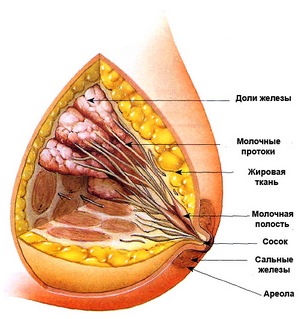 The internal filling of the mammary gland is several glandular lobes, subdivided into lobules filled with alveolar vesicles and interconnected by milk ducts. This structure looks like a bunch of grapes and is called the glandular department responsible for the secretion of milk. It is fed to the top of the nipple by the milk ducts expanding in this place.
The internal filling of the mammary gland is several glandular lobes, subdivided into lobules filled with alveolar vesicles and interconnected by milk ducts. This structure looks like a bunch of grapes and is called the glandular department responsible for the secretion of milk. It is fed to the top of the nipple by the milk ducts expanding in this place.
The mammary glands are permeated with lymphatic channels and blood vessels, in the corresponding position of their supports the ligamentous apparatus - Cooper's ligaments.
The glandular section is surrounded by loose tissues - connective and fatty. This contributes to the mobility of the mammary gland relative to its base and largely determines its external shape. There are even special classifications of types and forms of the female bust, as well as their relationship with the character of the owner. But one thing is certain: There are no two absolutely identical busts in nature. And yet, the formula for the ideal female bust exists, and it is characterized by such geometric parameters:
- the upper part of the mammary gland, mentally divided in half by a horizontal line running along the nipples, should make up 45% of 100% of the breast volume, and the lower part - everything else (55%);
- nipples relative to the same line should look up at an angle of 25 ° to 45 °.
Of course, the ideal tightened chest is as rare as the notorious parameters 90-60-90. But in a sense, every breast is perfect in its own way.
Muscular corset
The pectoral muscles are divided into two groups:
- located directly on the chest - internal, external and diaphragm;
- muscles of the shoulder girdle and arms.
The most massive is the fan-shaped convex pectoralis major muscle. Under it is a flat pectoralis minor muscle, which has 4 teeth and is attached to the scapula.
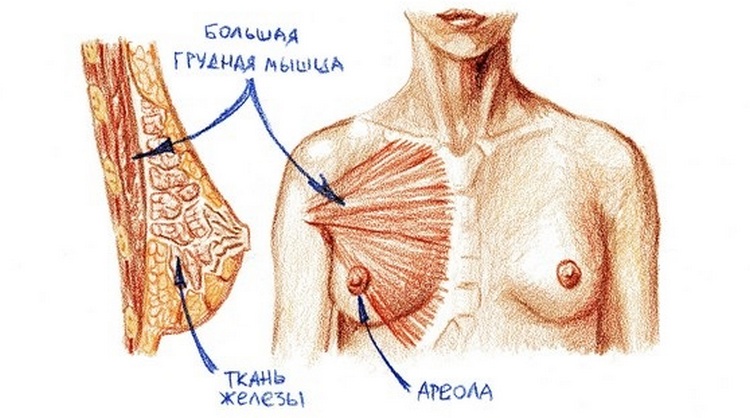
The functions of the chest muscles include:
- support of the upper limbs and, together with the muscles of the back, participation in turning, tilting and lifting the body;
- participation in the process of breathing with the help of the diaphragm.
What can affect how breasts look?
There are several factors:

- Body fat balance. Usually the mammary glands of fuller women are more impressive than thin ones. If a lady begins to lose weight intensively, as a rule, her breasts also decrease. we have discussed in a separate article.
- Pregnancy and lactation. During this important period, due to hormonal changes in the body, it undergoes a significant transformation and becomes fuller. But it is quite possible to correct the situation in this case.
- Age. Until the age of 20, the bust steadily increases and forms. After adulthood, estrogen no longer affects its shape and size. Here, pregnancy and childbirth, weight gain, etc., are already beginning to play a noticeable role. It is worth mentioning the “Balzac age”, when natural sagging processes begin due to a decrease in collagen production, stretching and weakening of the ligamentous apparatus, etc.
- Genetics. It is enough to look at the women of this or that family in order to assume with a high probability what shape and size the breasts of a girl born here will develop. Unfortunately, genetics is one of.
- Smoking. Cigarettes contain compounds that destroy elastin. The overall tone of the skin, including the bust, falls, and the mammary gland begins to sag.
- plastic surgery. With their help, you can significantly change the shape of the breast. But women should think about a lot before deciding on this extreme measure. The most gentle, but at the same time effective method of surgical intervention -.
7 main pull-up movements
As we found out, the mammary gland is attached with its base to the pectoralis major muscle. Is it possible to give it its former elasticity and what exercises can achieve this? The growth of the pectoral muscles, an increase in their endurance will improve the shape of the breast, enhance its nutrition, blood supply and lymphatic drainage, and become an obstacle to sagging and prolapse. We note right away that in addition to the workouts below, there are more.
What is important when working out the muscles of the chest:
- It is necessary to work out all the muscles to the maximum. The load must be multidirectional, because. the muscle fibers of the pectoral muscles lie at different angles.
- The correct technique for performing exercises is important to strengthen sagging muscles, without undue injury. Definitely a warm-up and a cool-down.
- Excellent exercises for are push-ups, pull-ups, various repulsions in strikes (tennis, basketball, volleyball), planks. But the most tangible results come from loads with progressive resistance. Among them - .
1. Knee push-ups
The muscles of the chest, shoulder girdle, back, abs, and triceps are involved. This is a basic multi-joint free weight exercise. Unlike standard full-length push-ups and other varieties, since it takes some of the load off the legs, and, accordingly, is easier to perform.
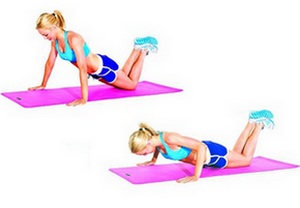
- From a prone position, focus on the palms and knees bent at an angle of 90 ° and legs crossed at the top. Straightened arms (palms are under the shoulders and look forward with fingers) and bent legs - shoulder width apart, the whole body forms an even inclined diagonal. This is the starting position.
- Inhale and begin to lower your torso down by bending your elbows until your chest touches the floor.
- Push off at the bottom and as you exhale, rise to the starting position.
Push up 10-12 times, do 3 sets with a break of half a minute.
Don't Make Technological Mistakes:
- When moving down, do not spread your elbows away from the body - this can overload the shoulder and lead to injury;
- Watch the pelvis - it should neither sag nor lift up, but make a straight line due to the inclusion of the gluteal muscles in the work;
- Stretch your wrists to avoid overloading them with unnatural positions and strong pressure;
- Lower yourself down using the strength of your arms, slowly, and not as if you were knocked down.
2. Classic push-ups
Classic push-ups are perfect for tightening the pectoral muscles in girls. The muscles of the shoulder girdle, back, abs, triceps are also involved, and also, unlike the previous version of the exercise, the legs.
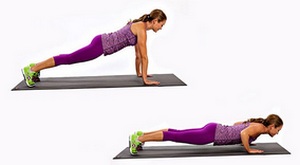
Technique - as in push-ups from the knees, but in the starting position, the emphasis is on the toes.
Push-ups 10-12 times, do 3 sets with a break of half a minute. Gradually bring the number of repetitions to 20 and reduce the break between sets to 10-15 seconds.
3. Squeezing the palms
The pectoral and shoulder muscles are included in the work, the inclusion of triceps is a mistake. Good for beginners with weakened muscles and as a final isometric exercise for strength training.
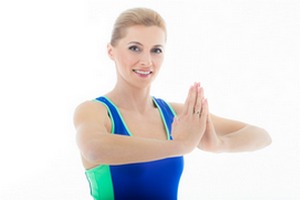
- Stand with your feet shoulder-width apart, your back is straight, bend your arms at the elbows in front of you at chest level, put your palms together and place them vertically (prayer pose).
- Inhale, hold your breath for 10 seconds and, while filling your chest with air, perform frequent maximum contractions of the pectoral muscles by resting your palms against each other.
Repeat 5-8 times for 10 seconds with a break of 10-15 seconds. Gradually work up to 20 seconds.
It is interesting! The exercise can be diversified by closing the arms above the head or shifting the closed hands alternately to the left and right chest.4. "Emphasis on the wall"
The muscles of the chest and shoulders are included in the work, tensing and stretching. The exercise is performed anywhere where there are doorways. It's good.
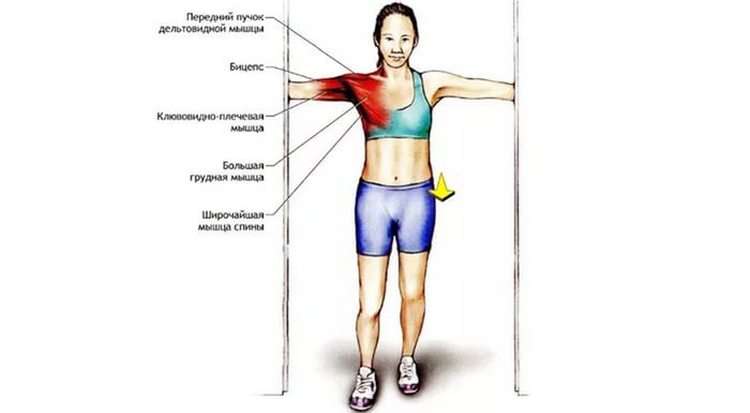
- Take the starting position, resting your arms slightly bent at the elbows on the sides of the doorway or wall, and begin to press them with your hands in the forward direction - about 1-3 minutes.
- Bend forward slightly and keep pushing down for another 1-3 minutes.
Three approaches will be enough.
5. Incline Dumbbell Press
An extremely effective exercise for lifting the pectoral muscles for women and girls. The work includes the large and small muscles of the bust, deltas and coracoid shoulders, muscles of the ribs, shoulder blades and biceps of the hands.
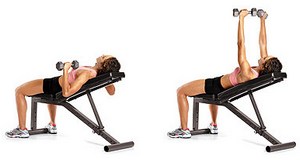
- Lie on a bench with an incline of 20°-30°, put your feet on the floor at your sides, raise your forearms with dumbbells up 90°. The position of the elbows apart just below chest level dumbbells - higher.
- Inhale, and as you exhale, squeeze the dumbbells up on straight arms, after a second delay at the top point, the arms return down.
Do 3-4 sets of 10-12 presses, with a break of about 2 minutes.
6. Wiring dumbbells lying on a horizontal bench
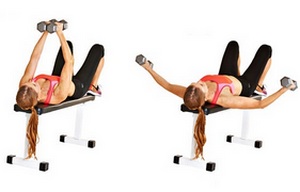 The pectoralis major muscle works, the muscles of the shoulders and ribs are included. This move is effective.
The pectoralis major muscle works, the muscles of the shoulders and ribs are included. This move is effective.
- Lie with your back on a bench, raise your arms with dumbbells slightly bent at the elbows up to eye level, hands look at each other.
- Inhale - spreading the arms to the sides, a slight delay at the bottom point, while exhaling - a new rise.
Do 4 sets of 12 dilutions.
7. Pullover exercise
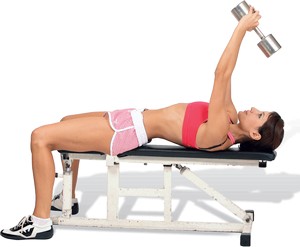 Large pectoral and
Large pectoral and


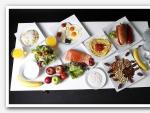
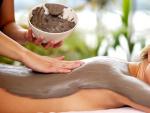
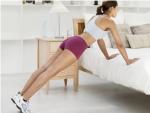
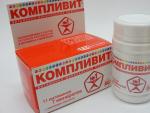
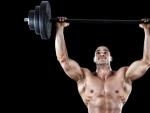

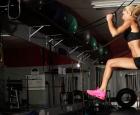 Fat Burning Cardio: Benefits, Program Options, Helpful Tips
Fat Burning Cardio: Benefits, Program Options, Helpful Tips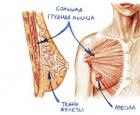 7 most effective exercises for breast lift at home - a complex for women and girls
7 most effective exercises for breast lift at home - a complex for women and girls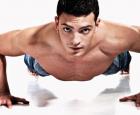 How to pump up at home in the shortest possible time?
How to pump up at home in the shortest possible time?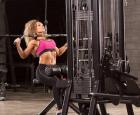 Technique and important tips for doing the exercise
Technique and important tips for doing the exercise